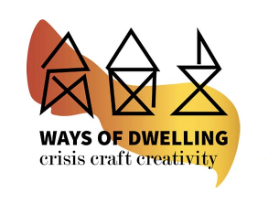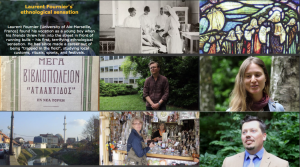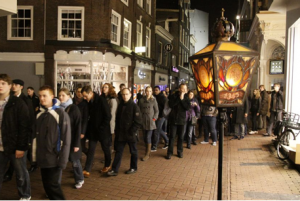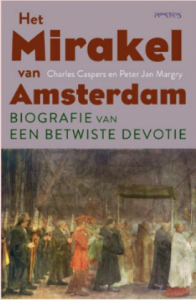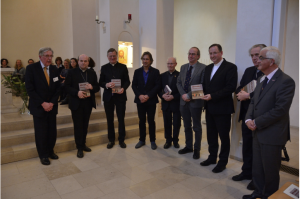The 16th international SIEF congress will take place in Brno, June 7-10-2023.
Three local partners host the congress: the Institute of Ethnology of the Czech Academy of Sciences, the Department of European Ethnology of the Faculty of Arts of Masaryk University and the National Institute of Folk Culture.
The theme is ‘Living Uncertainty’. SIEF2023 hopes to open a debate on uncertainty in Ethnology, Folklore and adjoining fields, both in terms of the uncertainty of everyday life and of epistemological uncertainty.
The Call for Papers is open!
Please have a look at … and submit your paper.
Important dates
Call for papers 14/11/2022-10/01/2023
Early Bird registration 06/03-17/04/2023
Congress 07/06-10/06/2023
For more information: follow the link.
Journal Ethnologia Europaea
At the end of 2020 Marie Sandberg and Monique Scheer have stepped down as editors-in-chief of the journal Ethnologia Europaea. They are succeeded by Prof. Laura Stark, University of Jyväskylä, and Prof. Alexandra Schwell, University of Klagenfurt.
Read the article about this subject: Sandberg M. & Scheer M., (2020) “Exitorial”, Ethnologia Europaea 50(2), p.5-6.
https://doi.org/10.16995/ee.3403
New Dates
Due to COVID-19 various SIEF activities have been shifted to a later date.
For a complete overview: see the calendar
SIEF2021
![]() In 2021 the University of Helsinki, Finland will be the host for SIEF2021, SIEF’s 15th international Congress.
In 2021 the University of Helsinki, Finland will be the host for SIEF2021, SIEF’s 15th international Congress.
The theme is: Breaking the rules? Power, participation and transgression.
Breaking rules can bring about change. Also, it can reveal (dis)ruptures in societies. What are the implications of ‘breaking the rules’ in various contexts?
As a result of COVID-19 the SIEF2021 congress will be fully on line.
For more information: follow the link.
News about SIEF’s journal Cultural Analysis
We are happy to announce that SIEF’s journal Cultural Analysis has recently published the special issue ‘The Inheritance of the Digital. Ethnographic Approaches to Everyday Realities In, Of, and Through Digital Technologies’, guest editors: Robert Glenn Howard and Coppélie Cocq.
Cultural Analysis has a new refreshed layout and is accessible at a new URL: www.culturalanalysis.org (and: https://www.ocf.berkeley.edu/~culturalanalysis/).
World Storytelling Day
Upcoming March 20 it’s World Storytelling Day again.
Every year, on the March equinox, storytellers all around the world tell stories in every language and in every place you can imagine. This tradition has it’s roots in a Swedish national day for storytelling and spread from the end of the 20th century gradually all over the world.
The stories travel with the time zones and for 24 hours this day is celebrated on every continent. Each year has his own theme. The theme if this year is ‘Wise Fools’.
In the Netherlands World Storytelling Day is coördinated by the Storytelling Foundation.
Panel discussion and book launch
On December 20, 2017 there has been a panel discussion on alternative medicine in Amsterdam, Spui 25. Four experts in this field -a scientist, a journalist, a health care consultant and a family doctor- highlighted this theme.
This panel discussion was organized as a result of the publication of the book Healing en ‘alternatief’ genezen. Een culturele diagnose, written by Peter Jan Margry (in Dutch). The book gives an ethnological approach to alternative medicine.
The official presentation of the book was also this afternoon.
Some views on ethnology
Curious about the way other ethnologists look at their profession, about their expectations, motivation or concern?
In a short film, recorded at the SIEF2017 conference in Göttingen, some SIEF members, coming from different countries, share their point of view about all this.
Interested? To watch the film:
go to ‘What Do Ethnologists Do’.
The ethnological sensation of Peter Jan Margry
In the latest episode of SIEF Ethnological Sensations Peter Jan Margry of the Meertens Institute in Amsterdam talks about a special road trip through southern France in the Seventies. There, visiting Rocamadour, an intriguing pilgrimage aroused his interest in ethnology.
Apart from Peter Jan Margry’s story there are many more interesting videos to watch about ethnological sensations.
To see the video about Peter Jan Margry, or more, go to SIEF Ethnological Sensations.
Reflections on SIEF 2017
From 26-30 March the 13th SIEF Congress has taken place in Göttingen, Germany.
In the SIEF newsletter (Spring 2017, Vol.15 No 1) several participants of the congress have put on paper their experiences in Göttingen as well as some suggestions for the next congress.
Interested in their impressions of the congress? See the SIEF newsletter.
SIEF Ethnological Sensations in a new smart portal
SIEF Ethnological Sensations is a fascinating resource for scholars, teachers, students and anyone interested in ethnology, folklore and related fields. The portal offers videos with interviews on various themes sorted by topic, for instance Cultural heritage, Everyday scenes, Fieldwork or Museums and archives, just to name a few.
In the videos, various scientists tell about their ethnological sensation or decisive experience doing their research.
Curious about it? Go to SIEF Ethnological Sensations.
A unique walk in Amsterdam
In an article in the Dutch paper ‘Haarlems Dagblad’ of March 18, 2017 Peter Jan Margry explains the ‘how’ and ‘why’ behind the annual tradition of the Silent Walk in Amsterdam. The Silent Walk is a pilgrimage that attracts every year in mid-March thousands of people to commemorate the Miracle of Amsterdam that took place on March 15, 1345.
This pilgrimage-walk is unique in the Netherlands and the story behind the silence while walking is an interesting piece of history.
Peter Jan Margry is researcher at the Meertens Institute in Amsterdam.
Read here the full article: Stille Omgang (PDF, in Dutch).
Source: ‘Plus’, the Saturday supplement of Noordhollands Dagblad, Haarlems Dagblad, Gooi- en Eemlander en Leidsch Dagblad.
Social Media
Ernst van den Hemel, researcher at the Meertens Institute in Amsterdam, examined 110.000 tweets of official accounts of the Dutch political party PVV. The PVV is twittering a lot about religious matters. The purpose of the study was to investigate what people of the PVV had to say about Judaism, Christianity and Islam in their tweets.
All tweets are entered in a database which is then searched, using terms related to religions.
For more information: read the article in the Dutch paper Trouw.
Sacred trees
Sacred trees are already a centuries-old worldwide phenomenon, in Europe dating back to pre-Christian Germanic, Celtic and Nordic cultures. Was the worship of the tree sanctuaries in the early Middle Ages banned by the Catholic Church -many sacred trees were cut down-, in time the worship of trees was included in the Catholic religious rites.
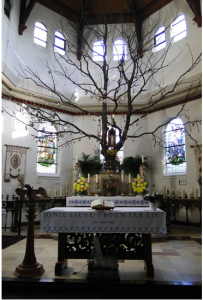
Oak with statue of Mary inside the chapel of Our Lady in the Oak, Meerveldhoven
Source: www.sinds1980.nl
Tree sanctuaries, but also other less famous trees, became pilgrimage trees and were often the subject of a miracle story. In the past there have been dozens of pilgrimage trees in the Netherlands and Belgium, today perhaps only a dozen or so.
In Meerveldhoven, an old village in the Dutch province of North Brabant, you can still see a special pilgrimage tree. A tree, associated with a miracle story about Mary, where a chapel was built over: the chapel of Our Lady in the Oak. The chapel is still a place of pilgrimage.
Want to know more about this topic? Read the article ‘Heilige bomen’ (Sacred trees) of Pancras Dijk in National Geographic of March 2017 (in Dutch).
The Dutch national anthem in bits and bytes
Since 1932 the ‘Wilhelmus’ is the official Dutch national anthem. In 1815, in the early years of the Kingdom of the Netherlands, there was need for a national anthem and the choice fell on a lyric of the poet Hendrik Tollens. But the ‘Wilhelmus’, in the century before used by a specific faction, remained popular by large groups of the population. Eventually, to put an end to this issue, the ‘Wilhelmus’ was chosen as the official national anthem.
But who is actually the author of the ‘Wilhelmus’, a 16th century anonymous lyric?
The researchers Mike Kestemont, Els Stronks, Martine de Bruin and Tim de Winkel want to give an answer to this question in their booklet ‘Van wie is het Wilhelmus?’ (‘Who owns the national anthem?’). The outcome is surprising, a completely new candidate pops up.
The oldest known version of the ‘Wilhelmus’ is in German and dates back to 1573, the oldest known Dutch version comes from the ‘Geuzenliedboek’ of 1576. Many people are convinced that Filips van Marnix van Sint-Aldegonde (1538-1598) is the author of the Wilhelmus, although there always have been more candidates for the authorship.
Apart from the question of the authorship the writers examine other issues such as: with which intention is the Wilhelmus written; which political and religious parties considered themselves in the course of the Dutch history owner of the Wilhelmus?
To answer these questions the researchers have made use of modern computer analysis of all sorts of lyrics. Both known as well as lesser known authors are involved in this comparative research.
After analyzing all entered texts and authors the computer attributes the authorship of the Wilhelmus to Petrus Datheen (1531-1588) as the best possible candidate. A remarkable outcome, according to the researchers, because Petrus Datheen was never in the picture in that context. Although Datheen was very popular in the 16th century by his metrical psalms, in the 18th century there was a lot of criticism because of his crippled rhyme and he was the butt of ridicule. Nevertheless, the booklet shows that there is enough evidence for Petrus Datheen as the author of the ‘Wilhelmus’.
Mike Kestemont, Els Stronks, Martine de Bruin, Tim de Winkel, Van wie is het Wilhelmus? Published: December 9, 2016. Series: Meertens New Year Expenditure.
Book launch
On January 21, 2017 was the festive presentation of the book Het Mirakel van Amsterdam. Biografie van een betwiste devotie, written by Charles Caspers and Peter Jan Margry in the chapel of Onze Lieve Vrouwe Gasthuis in Amsterdam.
The first copies of the book were handed over to the five bishops present.
The chapel of Onze Lieve Vrouwe Gasthuis was completely filled with the numerous guests who came to attend the book launch. They could listen to several introductions on the book. Speakers were professor Jan Bank, the president of Society of the ‘Stille Omgang’ (the Silent Walk), the both authors and the publisher. These introductions were accompanied by chants of the choir ‘Koor Gaat Door’. The chants the choir performed were so called ‘Mirakelliederen’ (‘Miracle Songs’).
Het Mirakel van Amsterdam (the Miraculous Sacrament) is about the interaction between sanctuary, pilgrims, city, nation and the quarrels that occurred in this context. The book offers a fresh perspective on a controversial and fascinating part of the history of Amsterdam and the Netherlands in the field of culture and religion.






